Porcelain Insulator News
by Elton Gish
Reprinted from "Crown Jewels of the Wire", February 2003, page 6
This month I will try to clean out a couple of reported items that we have
neglected to report. Both are significant and should have been reported long
before now. I get a lot of interesting reports that do not fit in nice neat
categories, so maybe we can get a few of them before you this month. And there
is a "new" Fred Locke marking, too.
The Purkey patent insulator,
U-186, has been in the hobby from almost the beginning and one of the favorites
of most porcelain collectors. The unique twist-lock design of the top allows a
wire as large as a pencil to drop in the top and, with a quarter turn; locks the
wire into place without the need for a tie-wire. However, a tie-wire could be
used wrapped securely under the crown.
The top is made up of two halves
glazewelded together. On some specimens you can see the glazeweld joint in the
center of the curved right side of the horizontal groove. The combined halves of
the top are then glazewelded on the bottom part. Wet process porcelain was used.
What makes it even more unusual is the embossed marking on top. Only one company
made embossed markings on wet process porcelain - Ohio Brass.
Typically, an
embossed marking indicates dry process porcelain. Ohio Brass used the embossed
O-B logo from 1907 to about 1940 when they switched to a recess-embossed
marking. The O-B marking was engraved on the crown area of the plunging mold in
an area not subject to removal by the later trimming operation. This was the
upper edge of the crown. On U-186, the embossed marking is on the nearly flat
top of the insulator. The identical marking is curved around this area on both
halves of the top. I suspect that both halves were identically marked because if
one of the halves did not have the marking, it would have been possible to put
two unmarked halves together during assembly and have an unmarked insulator.
Inventors were required to place either the patent date or patent number or
notice of patent pending on each item they produced. On most specimens, the
glaze either partially or almost entirely obliterates the marking since the
embossing is rather weak and the glaze somewhat thick. Usually just the "PEND'G."
is visible adjacent and parallel to the top groove.
Here is the complete marking (note the spelling error) that appears on both
sides of the top groove:
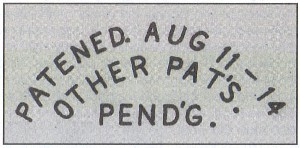
Benjiman S. Purkey lived in Tacoma, WA and all specimens of U-186 were found
in that area. He was granted two patents for his insulator. Patent No. 1,107,111
was granted on 8-11-14 and No. 1,251,416 was granted on 12-25-17. Since the
insulators were marked "Other Pat's Pend'g", we can assume all of the
insulators were made some time between 8-11-14 and 12-25-17. The second patent
application was filed on 5-4-14 and it added a rib in the horizontal groove
above and below the wire to aid in locking in the wire as it rested in the final
position. If you look closely at your specimen, you may be able to see these
slightly raised ribs. The ribs are so shallow that it probably did not serve as
intended.
Now back to the most interesting part of this discussion - the report
I alluded to earlier. Over three years ago Paul Keating (Tacoma, WA) sent me a
letter about the Purkey insulator. Paul has been collecting insulators since
1958 and a well-known name in the hobby. He said he obtained five U-186
insulators in Tacoma that were used on a 4 kV distribution line by a local
utility and by a public utility district on the Washington coast. One of the
five Purkey insulators had an embossed marking on the bottom side of the skirt.
The marking was only partially visible but it was definitely the O-B logo
marking of Ohio Brass!!
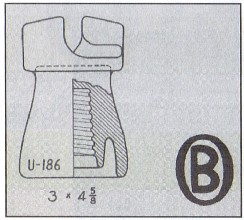 |
Several years ago Jeff Katchko reported an unusual knob insulator with a
previously unknown mark. It is one-half of the complete knob. The incuse marking
is:
MURDOCK
Pat'd Sep't
17 th. 1901.
|
The Murdock patent is No. 682,831 granted on 9-17-01. As you can see in the
patent drawing, it is made of two identical halves with four or more fluted
edges to grip the wire and mounted by means of a screw or bolt through the
center. Jeff's insulator was the only one known and currently it is the only one
known with a brown glaze. The Murdock insulator is obviously an early style and
we did not know who made it until a couple of years ago. Ken Willick has been
digging in one of the Victor dumps dating back to the time of Fred Locke
(1898-1904). He has found several Murdock insulators with the same incuse
marking; however, all of the ones he has found have been glazed white. We now
know that Fred Locke made the Murdock insulator. The insulator is almost
2-1/4" in diameter and the two halves together stand about 2-1/4" tall.
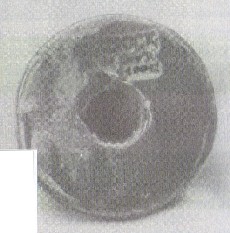
(top)
Brown half of MURDOCK insulator.
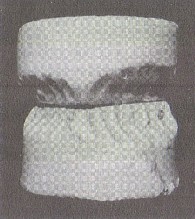
(middle & bottom)
Complete white MURDOCK insulator
showing the fluted
edges and separate
halves with marking.
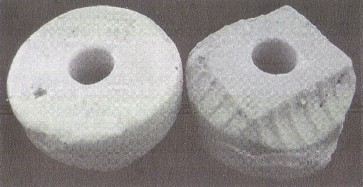
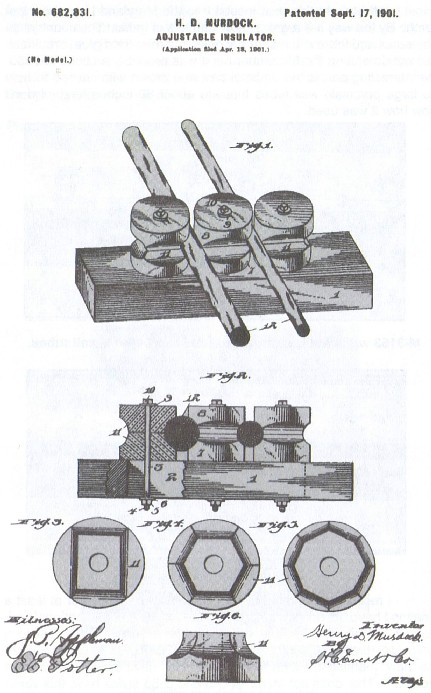
Jeff brought this next insulator to the Maryland Line show last March. By the
way it is a great show with lots of traffic. The countryside is beautiful and
there is a restaurant down the road for a great breakfast. I did not determine
the M-number but it was probably a Locke M-3153. The interesting part is the
unusual cast iron crown with clamps to hold two large porcelain wall tubes that
are about 30 inches long. I don't know how it was used.
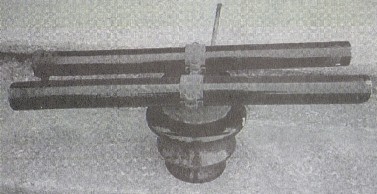
M-3153 with cast iron crown to hold two 30-inch wall tubes.
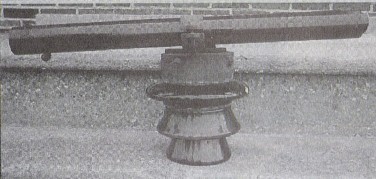
Close-up of cast iron crown.
I recently discovered a "new" Fred Locke marking or at least a
variation I have not noticed before. It apparently is a non-intentional
variation of marking #0-6. That marking appears only on the following styles:
U-3 (brown), U-39 (brown), U-55, U-220A/B, U-242, and U-330A. The "new"
marking is not on any of the styles I have except U-3 (brown) and U-55. That
does not mean all U-3 and U-55 styles have this variation and it does not mean
the other styles have the slight variation of the #0-6 marking. The variation I
am talking about is a large round dot at the upper left tip of the "V"
in "Victor". I have six U-3's with this large dot in exactly the same
location. I have one U-39 with a nice clear impression of marking #0-6, but it does not shown the dot. What makes all
this more interesting is the U-55 I have shows the same large dot, but it is far
to the left of the "V". I would like to hear from all of you who have
a similar marking on insulators in your collection. The dot variation is a
mystery. It definitely is not a stray period and it is consistent except for the
wandering dot on U-55.
Please let me know if you have something like this.
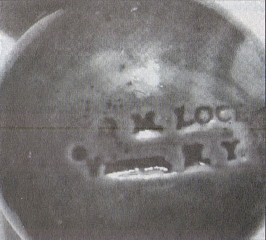
U-3 with the odd dot on marking #0-6.
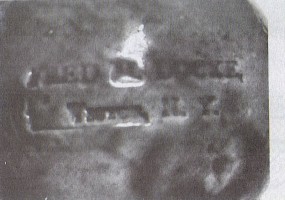
U-55 with the dot far to the left.
| 